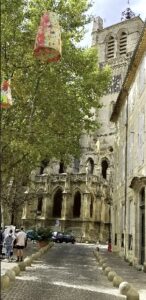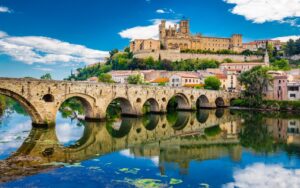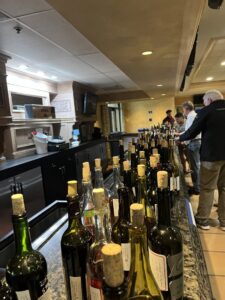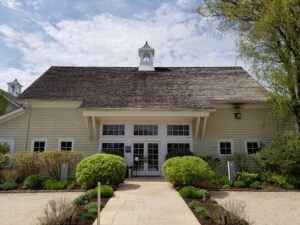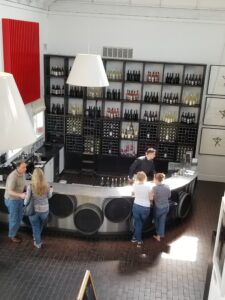As you drive into the town of Béziers in Southwest France, you’ll see signs welcoming you and announcing that you’ve arrived at the “world capital of wine” (capitale mondiale du vin). Now, this claim may be contested by the people in Bordeaux, Montecino or Napa. But it is fair to say that there’s a lot of wine made in the area around Béziers, in the heart of the Languedoc region, although even there Narbonne and Montpellier have a claim.
The town certainly has a lot of history. Researchers say that it has been occupied since 575 BCE. The Gauls lived there; the Romans conquered it; and it was considered to be a part of Spain until well into the Middle Ages. In the crusade against a heretic branch of Christianity, the Cathars, it was sacked and nearly destroyed in 1209. Béziers’ position along the Mediterranean made (and still makes) it a center of trade and so it sprang back to life.
The entrance to the Cathedral of Saint-Nazaire. The townspeople have decorated Béziers with colorful hanging lampshades.
Visitors today can still detect some of the ravages of that war. The Cathedral of Saint-Nazaire was re-erected afterwards and still dominates Béziers’ skyline. The entrance faces a pleasant square but most of the building is on top of a cliff and is unreachable. That’s because the conquerors didn’t trust the people of Béziers and re-built the cathedral to be a fortress if need be. Fortresses tend to be fairly gloomy inside and this church is no exception, but we recommend a coffee or a glass of that Béziers wine on the square by the cathedral, where you can admire the architecture.
If you’re in the mood to see other churches, we recommend the church of the Madeleine, where the people of Béziers were massacred in 1209. You can still see some of the scars of the battle on the exterior but the interior has been renovated since then and is more attractive than that of the cathedral.
Assuming that you’re interested in other things than churches and grisly history, such as food and wine, we do have some recommendations. For one, visit the grand covered market, Les Halles de Béziers. As a visitor, you may not be able to cook everything, but you can bring home some canned cassoulet or some herbes de Provence. We always enjoy a little of the region’s succulent fruit that we munch as we go along.
There are wonderful bistros everywhere in Béziers, but the area to the west of Les Halles is packed with them. Our experience is that it doesn’t matter which one you choose. They all serve the same local specialties and they’re all good. And of course you can wash your food down with some Languedoc wine, which is wonderfully inexpensive.
The Vieux Pont and the Cathedral of Saint-Nazaire. Photo courtesy of the Telegraph.
Be sure to see the Vieux Pont (old bridge) when you leave town. Erected in the 12th century, it’s a sight in itself. And from there you can admire the entire town, with the cathedral looming over everything. We guarantee, you’ll want to take pictures.
